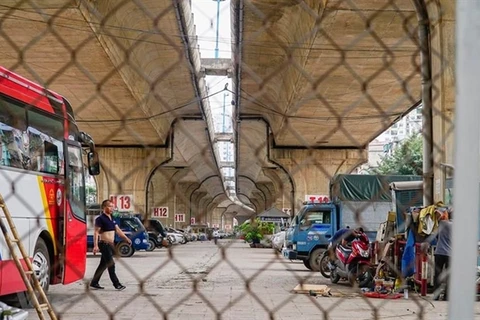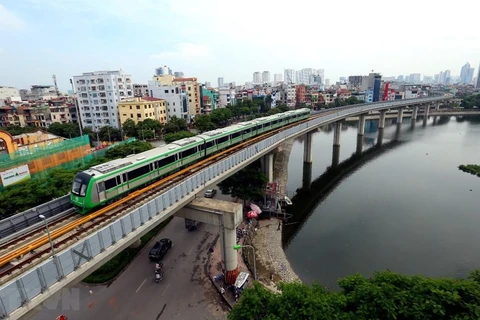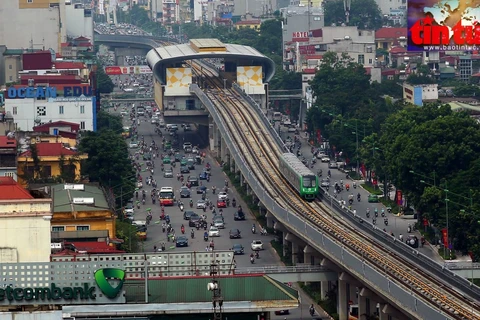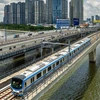Hanoi (VNS/VNA) - Hanoi’s population, as of July 2021, reached over 8 million, increasing by almost 200,000 people per year on average.
The capital city continues to grow, and new solutions are needed to manage this expansion. One idea being considered is further utilising underground spaces.
According to figures from the city’s traffic police, there are about 7.6 million vehicles registered in Hanoi, excluding 1.2 million vehicles from other cities and provinces that regularly travel to the city.
The growth rate of spaces for vehicles has not kept pace with this increase in vehicles, leading to an urban infrastructure overload, traffic congestion and air pollution.
One solution is to build an underground traffic system or even entire underground urban areas.
Since 1996, a number of commercial centres and hotels in Hanoi have built two to four levels of basements.
The city has also built a number of underground intersections such as underground tunnels of Kim Lien, Thanh Xuan and Trung Hoa, as well as underground technical infrastructure systems in drainage, electricity and water supply lines.
By the end of 2020, a private housing project in Ba Dinh district on an area of more than 300sq.m will include up to four basements.
Vice President of the Vietnam Urban Development and Planning Association architect Dr Dao Ngoc Nghiem told Kinh Te & Do Thi (Economics and Urban Affairs) newspaper that it is time that underground space became an important consideration in urban development strategy.
Dr Pham Hung Cuong, former head of Architecture and Planning at the Hanoi University of Construction, said: "The development of underground space includes two aspects of public space and public transport system. If done well, it will solve a lot of urban problems.
"However, Hanoi is only in the early stages of developing these two aspects. If there was no planning soon there will be many difficulties. The first problem will be the basements of the high-rise buildings that had been built,” Cuong said.
“By that time, the underground traffic routes will have to go around, which will be costly and controversial. This is the case regarding the C9 underground station near Hoan Kiem Lake," he said.
Therefore, Hanoi needs to focus on underground planning sooner rather than later, to develop a plan that aligns with the whole city.
The planning of underground space is only mentioned, but not expanded upon, under current regulations, such as the Plan of Hanoi construction up to 2030, with a vision to 2050, approved by the Prime Minister in Decision No. 1259/QD TTg, and the Hanoi Transport Planning to 2030 and a vision to 2050 approved by the Prime Minister in 2016.
In addition, there are no recommendations and research results for land use plans for building underground spaces, according to the director of the Hanoi Planning and Architecture Department, Nguyen Truc Anh.
Adjustments in how construction in Hanoi is planned are needed, with proposals on specific locations, areas, and scope of the city’s main underground spaces, as well as planning how to maximise land and urban space, he said.
The Hanoi Construction Planning Institute has just completed an underground space project for the city and submitted it to the municipal People's Committee for approval in the near future.
According to the plan, underground road traffic routes are mainly arranged at intersections, squares, railway and metro stations.
Notably, 79 underground public parking lots will be built in nine inner-city districts. Total construction will cover an area of 107 hectares.
The parking areas will be from three to five level basements, in combination with commercial and service centres.
Underground stations for the urban railway network will be the nucleus of future underground public spaces around a radius of 500m.
There will be 65 underground public spaces with a total area of 2,171 hectares./.
The capital city continues to grow, and new solutions are needed to manage this expansion. One idea being considered is further utilising underground spaces.
According to figures from the city’s traffic police, there are about 7.6 million vehicles registered in Hanoi, excluding 1.2 million vehicles from other cities and provinces that regularly travel to the city.
The growth rate of spaces for vehicles has not kept pace with this increase in vehicles, leading to an urban infrastructure overload, traffic congestion and air pollution.
One solution is to build an underground traffic system or even entire underground urban areas.
Since 1996, a number of commercial centres and hotels in Hanoi have built two to four levels of basements.
The city has also built a number of underground intersections such as underground tunnels of Kim Lien, Thanh Xuan and Trung Hoa, as well as underground technical infrastructure systems in drainage, electricity and water supply lines.
By the end of 2020, a private housing project in Ba Dinh district on an area of more than 300sq.m will include up to four basements.
Vice President of the Vietnam Urban Development and Planning Association architect Dr Dao Ngoc Nghiem told Kinh Te & Do Thi (Economics and Urban Affairs) newspaper that it is time that underground space became an important consideration in urban development strategy.
Dr Pham Hung Cuong, former head of Architecture and Planning at the Hanoi University of Construction, said: "The development of underground space includes two aspects of public space and public transport system. If done well, it will solve a lot of urban problems.
"However, Hanoi is only in the early stages of developing these two aspects. If there was no planning soon there will be many difficulties. The first problem will be the basements of the high-rise buildings that had been built,” Cuong said.
“By that time, the underground traffic routes will have to go around, which will be costly and controversial. This is the case regarding the C9 underground station near Hoan Kiem Lake," he said.
Therefore, Hanoi needs to focus on underground planning sooner rather than later, to develop a plan that aligns with the whole city.
The planning of underground space is only mentioned, but not expanded upon, under current regulations, such as the Plan of Hanoi construction up to 2030, with a vision to 2050, approved by the Prime Minister in Decision No. 1259/QD TTg, and the Hanoi Transport Planning to 2030 and a vision to 2050 approved by the Prime Minister in 2016.
In addition, there are no recommendations and research results for land use plans for building underground spaces, according to the director of the Hanoi Planning and Architecture Department, Nguyen Truc Anh.
Adjustments in how construction in Hanoi is planned are needed, with proposals on specific locations, areas, and scope of the city’s main underground spaces, as well as planning how to maximise land and urban space, he said.
The Hanoi Construction Planning Institute has just completed an underground space project for the city and submitted it to the municipal People's Committee for approval in the near future.
According to the plan, underground road traffic routes are mainly arranged at intersections, squares, railway and metro stations.
Notably, 79 underground public parking lots will be built in nine inner-city districts. Total construction will cover an area of 107 hectares.
The parking areas will be from three to five level basements, in combination with commercial and service centres.
Underground stations for the urban railway network will be the nucleus of future underground public spaces around a radius of 500m.
There will be 65 underground public spaces with a total area of 2,171 hectares./.
VNA

























